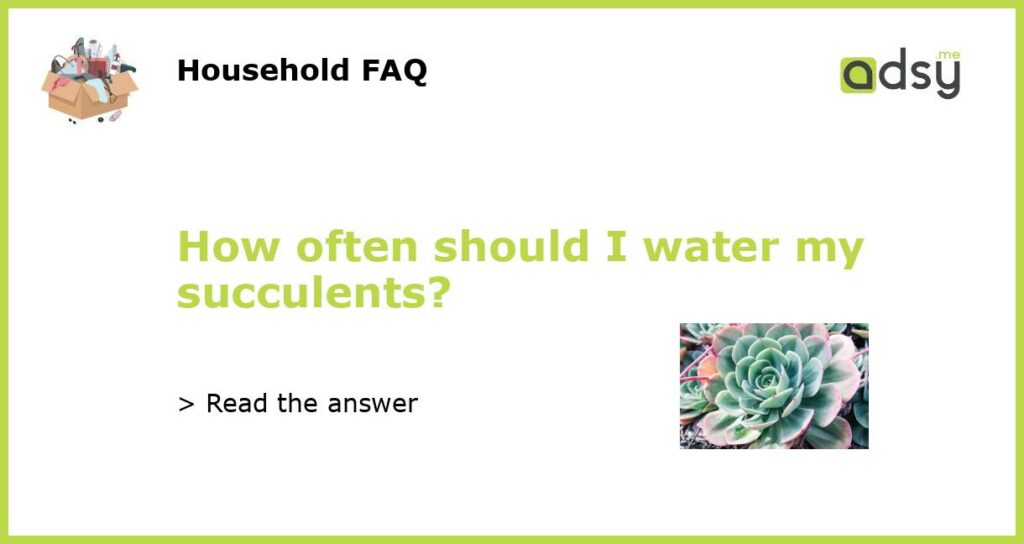Understanding the Watering Needs of Succulents
Succulents are a popular choice for indoor and outdoor plants due to their unique appearance and low maintenance requirements. One of the most common questions that succulent owners have is how often they should water their plants.
It’s important to understand that succulents are desert plants, and they have adapted to thrive in arid conditions. This means that they are capable of storing water in their leaves, stems, and roots, allowing them to survive for extended periods without being watered.
Overwatering is one of the biggest mistakes that succulent owners make. Too much water can cause root rot and other issues that can ultimately lead to the death of the plant. On the other hand, underwatering can result in dehydration and wilting.
Factors Affecting Watering Frequency
The frequency with which you need to water your succulents depends on several factors, including the climate, the type of succulent, the potting mix, and the growing conditions.
In general, succulents need more water during their active growth period, which is typically in spring and summer. During this time, they are actively producing new leaves and stems and may require more frequent watering. On the other hand, succulents tend to be dormant during the winter months and require less water.
The type of succulent also plays a role in determining watering frequency. Some succulents, like Aloe vera, have thicker leaves and can tolerate less frequent watering, while others, like Sedum, have thinner leaves and may require more frequent watering.
The potting mix used can also affect how often you need to water your succulents. Well-draining soil is crucial for preventing waterlogged roots. Succulents should be planted in a mix specifically formulated for succulents and cacti, or a mix that includes components like perlite or sand to improve drainage.
Growing conditions, such as the amount of sunlight and humidity, can also impact watering frequency. Succulents in bright, sunny locations may dry out more quickly and require more frequent watering, while those in shadier areas may need less water.
Signs Your Succulents Need Watering
To determine when it’s time to water your succulents, look for signs that indicate they are getting thirsty. Some common signs include:
- Leaves that appear wrinkled or shriveled.
- Leaves that feel soft and squishy when gently pressed.
- Leaves that lose their natural color and become yellow or translucent.
- Leaves that start to droop or wilt.
When you notice these signs, it’s time to give your succulents a drink. However, it’s crucial not to rush into watering, as it’s better to underwater than to overwater. Always check the moisture level of the soil before watering.
Watering Techniques for Succulents
When it’s time to water your succulents, it’s important to do it properly to avoid issues like root rot. Here are some tips for watering your succulents:
- Water thoroughly: When you water, make sure to thoroughly saturate the soil until water drains out of the drainage holes. This ensures that the entire root system is well-hydrated.
- Avoid misting: Misting or spraying water on the leaves of succulents is not an effective way to hydrate them. It’s best to water the soil directly.
- Water from the base: Pour water directly onto the soil rather than on the leaves or stem. This prevents water from sitting on the leaves, which can lead to rot.
- Allow proper drainage: Succulents should be planted in pots with drainage holes to allow excess water to escape. If the pot doesn’t have drainage holes, consider repotting your succulent.
- Observe the soil moisture: Before watering, check the moisture level of the soil by sticking your finger one inch into the soil. If it feels dry at that depth, it’s time to water.
Adjusting Watering Frequency as Needed
It’s important to remember that there is no one-size-fits-all answer to how often you should water your succulents. You may need to adjust your watering frequency based on the specific needs of your plants and the conditions in which they are growing.
If you notice that your succulents are constantly showing signs of underwatering, you may need to increase your watering frequency slightly. On the other hand, if your succulents are consistently overwatered and have root or leaf rot, you may need to cut back on watering.
Remember to always observe your succulents closely and pay attention to their individual needs. With time and experience, you will become better at understanding when your succulents need water and how much water they require to thrive.






